The practice of enterprise architecture planning is usually found only in the largest organizations and government agencies. The complexity of massive IT efforts is often addressed with equally complex planning strategies, and smaller businesses do not have the resources or the appetite for such heavy investments.
Today, though, the critical nature of technology and radically new models for IT delivery are making architectural planning a necessity. Just as a business plan is required to chart the future of a company, an IT architecture plan is required to build success in a digital economy.
Architectural planning is tightly coupled with digital transformation
As companies transform into digital organizations, they are not only adding new technology, but also building new structure and processes. Overall business operations are changing, and the goal of enterprise architecture planning is to start with corporate goals and move backwards to the optimal technology solution. This is not just an IT activity, but it gives IT a new role to play within the organization.
Long-term planning will be a new exercise for most firms
Only 34% of firms claim to currently build IT architecture strategies beyond a 12-month window. Although the pace of technology is increasing, it is still difficult to consider far-reaching changes to an IT environment without a broader horizon. Companies cite need for improvement across all four functional areas of IT, and one of the primary benefits of architectural planning is the ability to prioritize investments across different areas.
Cloud computing highlights a need for planning
Initial adoption of cloud computing typically involves the use of a SaaS application or migration of an existing system into cloud infrastructure. While these activities present some significant challenges, they are still relatively simple compared to a full transformation into a cloud-first operation. The top challenge for companies as they utilize cloud solutions is integration with existing systems, showing that in-depth planning is needed to maximize the benefits of a cloud strategy.
The need for planning will grow with IoT
Most companies are in the early stages of adoption with Internet of Things, with few companies actively starting IoT initiatives and most waiting on the sidelines while they build knowledge around the technology. However, it is clear even in these early days that IoT typically starts from a business objective rather than an existing IT practice. This focus on corporate goals along with the broad range of technology needed for a full IoT implementation creates a compelling case for strategic planning.
Throughout the relatively short history of information technology, there have already been three distinct stages in the evolution of business usage and behavior. The first stage was defined by mainframes, where IT systems performed isolated functions and were available to very few companies. In the second stage, diversity of back end components combined with the introduction of front end devices to create a more complex situation, and the discipline of enterprise architecture planning (EAP) was born.
The origins of EAP can be traced to a 1987 article written by J.A. Zachman for IBM Systems Journal. The title of the article was “A Framework for Information Systems Architecture,” and the motivation behind the piece was Zachman’s belief that managing the complexity of IT systems had become a business imperative. As IT architecture expanded and organizations became more dependent on technology, a systematic approach was needed to ensure productivity.
The first major adopter of a Zachman-inspired approach was the U.S. government. Starting with the Department of Defense and eventually spreading to other agencies, the U.S. government recognized the potential benefits in asserting a standardized methodology for building and planning IT architecture. The private sector also started showing interest in EAP, and various methodologies were built in an attempt to codify this new space.
The problem was that the methodologies themselves were also fairly complex. The only organizations willing to invest in complicated architectural planning were those able to benefit from optimizing massive systems (and those that had the resources to tackle such a project).
That brings us to the present. The third stage of IT evolution is built on cloud computing and mobile devices, and companies of all shapes and sizes are facing new realities around both tactical and strategic IT. The importance of digital operations and the availability of new models makes future planning a more critical activity.
Most companies will not necessarily embrace EAP as it has been defined over the past three decades. Formal definitions and rigorous processes will still prove too onerous or resource-intense, especially at the SMB level. However, the general concepts underlying EAP should find a more receptive audience. While EAP may evoke thoughts of high-priced consultant teams driving multi-year projects, the practice of aligning business objectives with technical infrastructure is one that many companies can improve as they go through digital transformation.
This study looks at the current state of enterprise architecture planning, whether that planning is done formally or informally. What steps are companies taking to build for the future? What hurdles are standing in the way? How are cloud computing and Internet of Things impacting architectures? There are many questions facing companies as they integrate technology throughout the organization, and the firms that succeed will be the ones that proactively answer these questions with solid planning efforts.
Zachman: The Zachman Framework for Enterprise Architectures is best understood as a taxonomy, describing components of an enterprise architecture rather than providing a planning process. Across six architectural focal points and six primary stakeholders, the Zachman Framework defines the components and outputs of an IT architecture.
TOGAF: The EAP efforts of the DoD led to the Technical Architecture Framework for Information Management (TAFIM). In 1998, TAFIM was retired by the DoD and handed to The Open Group, which developed The Open Group Architectural Framework (TOGAF). The key part of TOGAF is the Architecture Development Method (ADM), which defines a process for specifying architecture based on business input.
FEA: In 1996, a council of governmental CIOs was created in response to the Clinger-Cohen Act, which mandated that federal agencies improve IT effectiveness. This council created a framework which eventually became the Federal Enterprise Architecture (FEA) under the Office of Management and Budget (OMB). FEA is focused on the U.S. government, but the taxonomy and process can also be applied to private companies.
Gartner: As a result of growing private sector interest, Gartner acquired The Meta Group in 2005 in an attempt to build EAP expertise. The end result of this acquisition was not a specific taxonomy or procedure, but best practices that were folded into Gartner’s overall consultative approach. With a focus on business outcomes, Gartner’s methodology is perhaps the most practical but also contains few explicit steps or components.
The overarching premise behind enterprise architecture planning is the same as that behind digital transformation: the needs of the business are the starting point. Neither activity is primarily about technology. Instead, business objectives drive focused, collaborative decisions around corporate systems.
This represents a huge shift in the role of IT. Rather than being primarily tactical, supporting the business units which drive the corporate mission, IT now operates in a strategic capacity, helping select and implement the technology that will best enable the business to meet its goals.
As such, the overall mindset and practices around technology begin to grow more aggressive. Currently, companies self-assess their technology behavior along a traditional bell curve. This assessment has remained consistent throughout CompTIA’s research in recent years. Moving forward, though, the dependence on technology for business success will force more intentional practices.
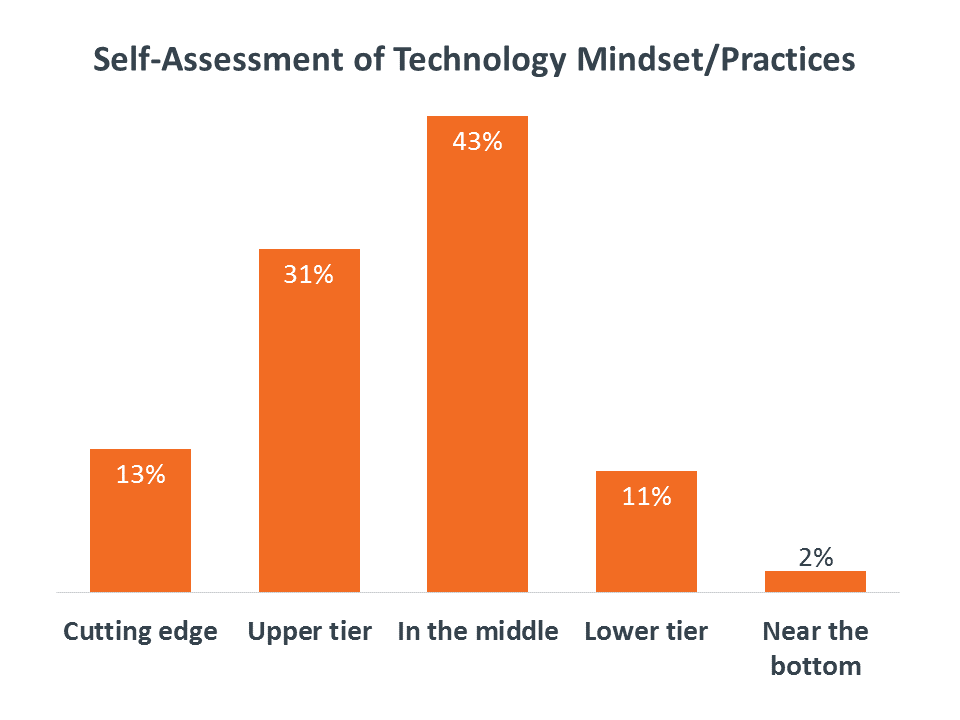
How exactly do firms move towards the cutting edge? It turns out there is a strong correlation between technology mindset and business needs acting as a driver. Among firms with more advanced technology utilization, 52% say that senior leadership which supports and funds technology initiatives is a key part of the advanced approach. On the other hand, among firms with less advanced technology utilization, 44% say that insufficient spending on technology initiatives (driven from budgets set at executive levels) is holding them back from a stronger approach. In both situations, the vision/support/budget set by leadership is the primary factor in setting the mindset.
As much as firms are moving towards a business-driven approach to technology, there is still work to do on creating environments that are truly collaborative. When considering those individuals responsible for planning IT architecture, 42% of companies cite the CIO or head of IT, and 31% of companies cite the CEO or owner. From there, things drop dramatically. Only 19% of companies cite the CFO or head of finance, and just 8% of companies cite the CMO or head of marketing.
For IT professionals or IT solution providers, the challenge in building consensus around architecture planning is twofold. First, they must ensure that discussions start with business needs. Technical workers must understand the ultimate goals; “We need a new communication tool” could mean “We need to enable remote workers” or it could mean “We need to connect internal activities with customer inter- actions.” The IT department may suggest different steps to a final solution based on the objective.
Second, collaboration throughout the organization must extend to a basic understanding of the architecture. CompTIA’s Considering the New IT Buyer study explored the increasing technical activity among lines of business. The activity is growing as familiarity with SaaS products and other endpoint solutions rises, but it is also limited as business units do not have deep architectural expertise. As business needs drive technology decisions, that influence must drive all the way down to the interconnected systems that form the comprehensive IT environment.
The amount of IT architecture planning being done varies widely from company to company. Around three-fourths of all businesses perform some amount of planning, though less than half of this group is looking beyond the current fiscal year. As expected, small firms (1-99 employees) are the least likely to engage in planning activity, with 41% of these firms doing no planning at all compared to 20% of medium-sized firms (100-499 employees) and 12% of large firms (500+ employees).
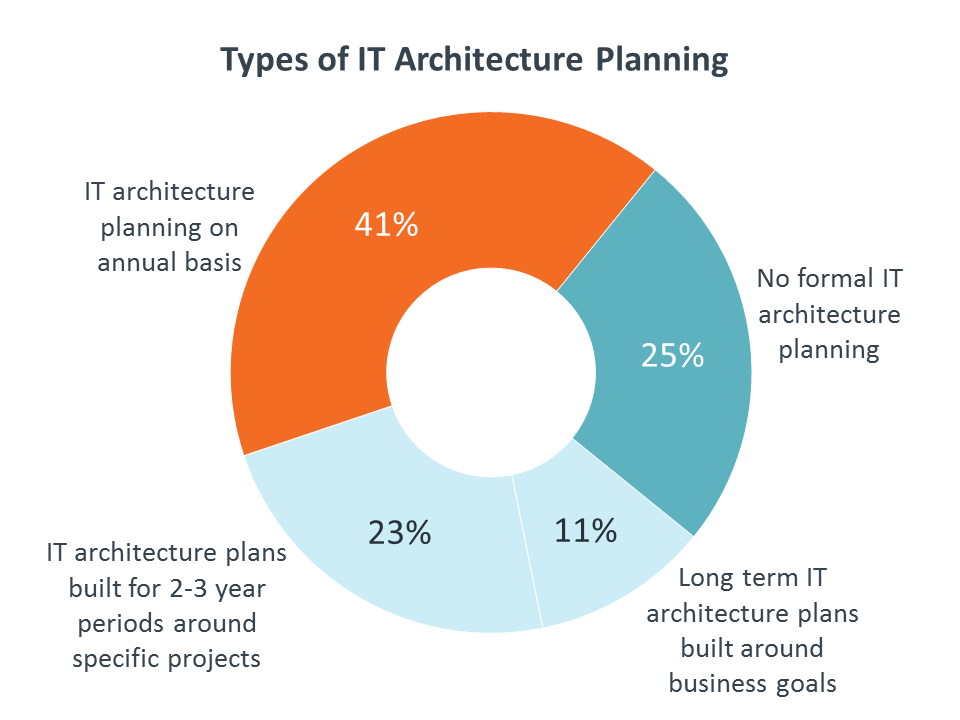
Across all types of informal and formal architecture planning, there are different viewpoints on the focal points of the efforts. The least common approach centers around the components of an IT architecture, with 22% of companies favoring this method. While most long-range plans may focus on other areas, there is still room to be more strategic with components: 30% of firms only replace components when they reach end of life by breaking or expiring, and 40% of firms replace components whenever they discover a better option. Few firms proactively plan replacement of components, suggesting a lack of proactive work in exploring new infrastructure options.
The second most popular approach to architecture planning is a user-centric model. In general, end users are becoming more of a focal point in the technology landscape. CompTIA has previously noted how the end user experience is a defining characteristic in the cloud/mobile era of computing. However, the segment of companies indicating a user-centric architectural approach was dominated by those firms that performed no formal planning. It is likely that instead instead of focusing on technology that actively enhances the work done by the end user and the experience of progressing through a workflow, these companies are simply looking for tools that make end users more productive. This in itself is not a bad goal, but it is not as advanced as building an architecture around user experience.
Finally, 47% of firms surveyed favor a data-centric approach to planning. Not only is this model more advanced than a component-centric approach, but it also fits better with long-range planning. Fifty-one percent of firms that do annual planning and 54% of firms that do multi-year planning center their efforts around the data flowing through the company.
Regardless of where companies focus their planning efforts, most report that improvement is needed across the entire IT architecture. CompTIA’s Functional IT Framework report described this architecture in four parts: Infrastructure (primarily consisting of hardware administration and tech support), Development (driving customization and auto-mation with software), Data (moving past data management to analysis and visualization), and Security (adding processes and education to technical defenses).
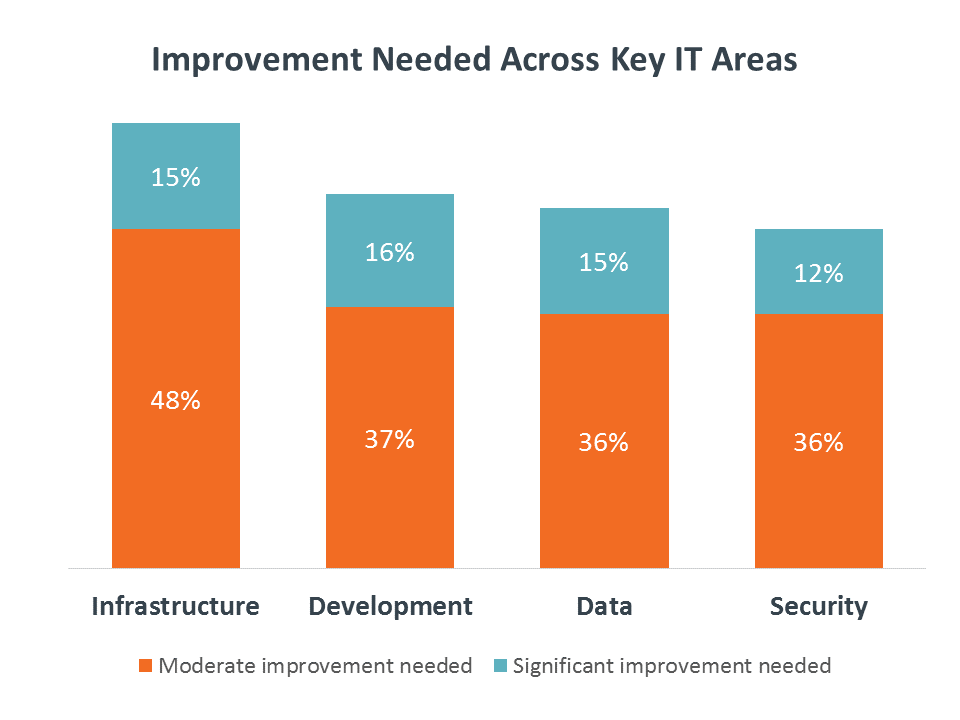
With changes needed across all functional areas, broader planning strategies are growing more common. The top action businesses plan on taking in the coming year to address IT deficiencies is to build a long-term plan, cited by 36% of firms. These plans can help guide other more discrete actions, such as investment in new components or training/ hiring to close skill gaps. Large firms are the most likely to consider any of these actions thanks to their breadth of resources, but long-term planning is still a top choice for medium-sized firms and small companies.
As technology takes more and more of a strategic flavor, IT professionals and solution providers must provide more business justification for tech investments. With an initiative as complex and far-reaching as architectural planning, the rationale must be exhaustive, carefully weighing benefits and challenges to ensure value for the organization.

Whether companies pursue formal planning efforts or informally assemble their IT architecture, they report several benefits in a structured approach. First and foremost, holistic planning helps achieve the goal that many businesses are striving for in their digital transformations: better collaboration between IT and business units. By connecting the construction of IT architecture to the overall corporate objectives, both technical teams and functional lines of business can be better informed about the options available and the tradeoffs involved when selecting devices, applications, or operational models.
The next two benefits go hand in hand. As technology budgets have spread beyond IT departments into business units, it has become more difficult to collectively prioritize technology investments. There are myriad options available, and without an overarching plan, piecemeal tech solutions can lead to a sprawling, unmanageable environment. Architectural planning can provide a venue for investment discussions and also ensure that individual investments fit into both the existing architecture and the future state (if that future state is defined).
All of these activities lead to a comprehensive process for the way that a business evaluates and procures technology. Most businesses are moving away from pure rogue IT, where business units have complete independence to select technology for their department. For various reasons, such as security and integration, the IT team continues to be involved in these discussions, and architectural planning can be the platform that enables collaboration.
Of course, building a plan is not without challenges. Naturally, many companies feel that they lack the budget for any substantial investment, rendering planning discussions moot. As companies go through digital transformation, they will likely have to re-evaluate the size and structure of their technology budgets.
Beyond budgetary concerns, it is clear that the complexity of the modern IT landscape is a hurdle for many businesses. Companies may be hearing about new trends and buzzwords but do not have enough knowledge on these topics to formulate a plan for integration. Even with sufficient knowledge, optimal use of new technology may require significant changes to the existing environment. Dealing with legacy concerns, where there are many sunk costs, makes it difficult to imagine a fully transformed architecture.
As much as formal architecture planning using an official framework may seem arduous, very few companies say that the concepts involved are too difficult to implement. Every detail of a given framework may not be followed, but they are at least good starting points for establishing a path towards better collaboration and business value.
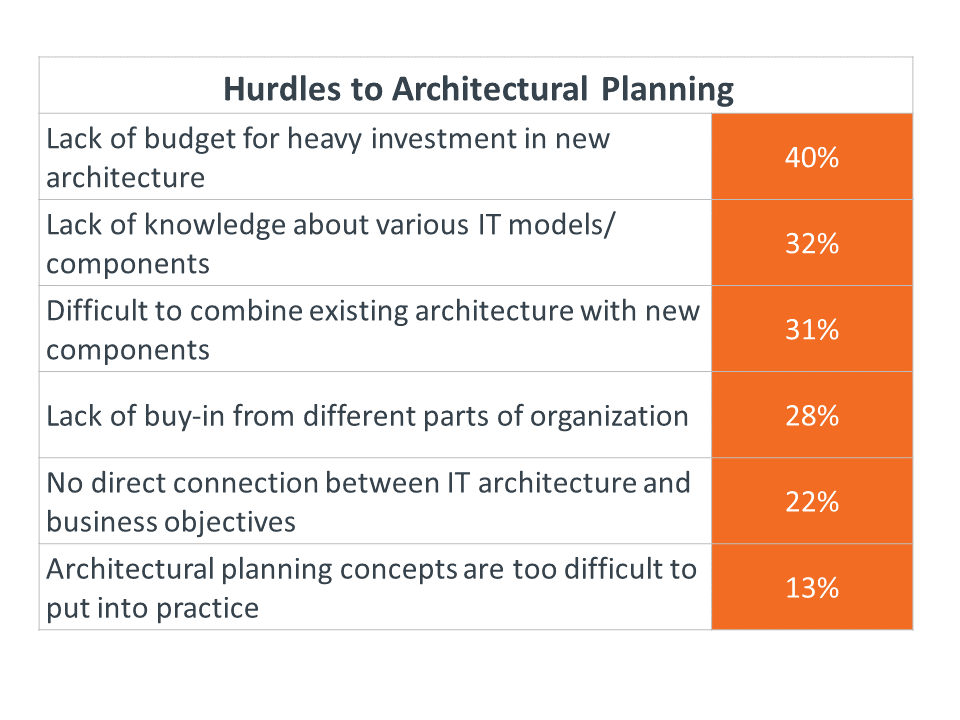
Beyond budgetary concerns, it is clear that the complexity of the modern IT landscape is a hurdle for many businesses. Companies may be hearing about new trends and buzzwords but do not have enough knowledge on these topics to formulate a plan for integration. Even with sufficient knowledge, optimal use of new technology may require significant changes to the existing environment. Dealing with legacy concerns, where there are many sunk costs, makes it difficult to imagine a fully transformed architecture.
As much as formal architecture planning using an official framework may seem arduous, very few companies say that the concepts involved are too difficult to implement. Every detail of a given framework may not be followed, but they are at least good starting points for establishing a path towards better collaboration and business value.
Cloud computing continues to be one of the dominant forces shaping the IT landscape. In the previous two eras of enterprise technology, various tools and methodologies changed the way that companies performed back end computing. In the current cloud era, improvements in processing power and especially in connectivity have allowed for a completely new model, disrupting decades of history and forcing companies to rethink architectural designs.
While CompTIA’s 2016 Trends in Cloud Computing study found many companies re-evaluating cloud usage as market knowledge improved, it is still safe to say that most companies at this point have some percentage of their systems in the cloud. Software as a Service continues to be the dominant cloud model, with 65% of companies reporting some SaaS usage. Platform as a Service follows with 42% adoption, picking up as more companies explore internal software development. Finally, Infrastructure as a Service completes the picture with 27% adoption, as many companies likely continue to discover that not all hosted models are cloud models.
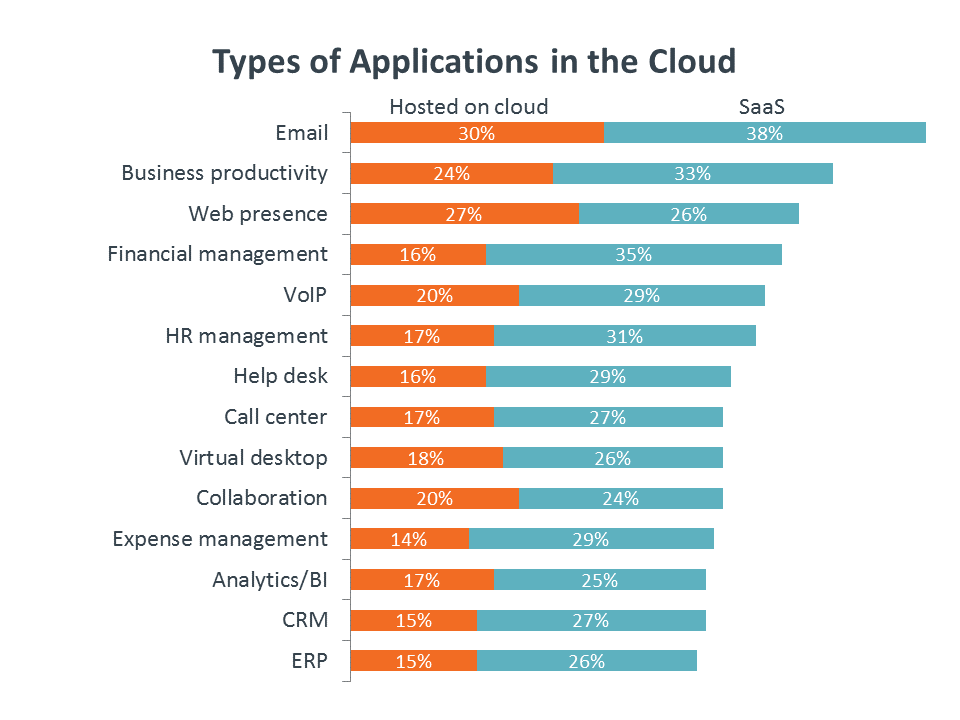
Understandably, email and business productivity lead the pack in terms of cloud-based applications. These are extremely common tools found in nearly every business, and vendors are making it easy to transition from traditional licenses to cloud implementations. Following these top choices, the types of applications quickly become tightly clustered, showing both the breadth of cloud migrations and also the growing appetite for digital operations.
For some time, the IT industry has treated the high degree of cloud activity as a signal that cloud skills need to be added to existing activities and offerings. This is certainly true, but that mentality only helps companies in the early stages of cloud adoption. Later stages require modification to workflow and redesign of infrastructure, two areas directly impacted by architectural planning.
The top challenge for companies as they utilize cloud solutions is integration with existing systems. This challenge has grown over time, surpassing other early-stage difficulties such as the learning curve for the cloud model and difficulty in estimating cost. The lessons learned in the first years of the cloud era can ease some of the growing pains around education and initial migrations, but eventually companies want maximum efficiency from their IT setup, and the integration of evolving systems must be carefully engineered.
By starting with the needs of the business, a good architectural plan will develop a proper set of priorities. These priorities can then help drive trade-offs as a wide range of applications are being considered along with the hosting model for each application. The architectural plan should also account for the data needed for each IT component. This data may be consolidated or it may be in silos, but the bulk of it is typically in place already—one huge challenge in adding new pieces is ensuring availability of data, and cloud systems can help organize data stores for comprehensive use and analysis.
Another reason for more rigorous planning in the cloud era is the complexity of managing a multi-cloud environment. Approximately one in five businesses have undertaken at least one secondary migration, moving IT components between cloud models or back on-premises. Smaller firms are the least likely to have performed these actions, but they will eventually need to optimize across models as they transform their business operations. The degree of difficulty rises with a multi-cloud approach, and the lack of resources in small businesses will drive them to seek help with planning and execution.
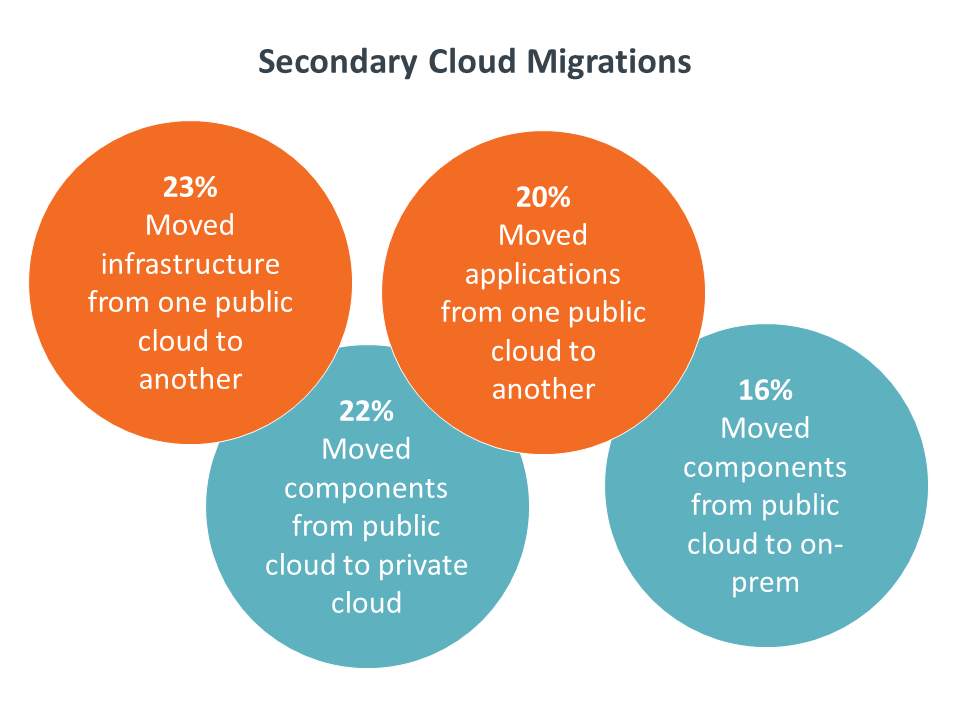
If cloud computing is the current trend driving a need for architectural planning, then Internet of Things is the future driver. Cloud computing is redefining the way that IT infrastructure is built; IoT is dramatically expanding the scope and scale of that infrastructure.
The primary characteristics of IoT are intelligence and connectivity. Physical objects that previously had no digital capability are being outfitted with sensors, CPUs, and network connections. This provides significant new opportunities in data capture/analysis and automation, but it also presents significant new challenges to IT operations.
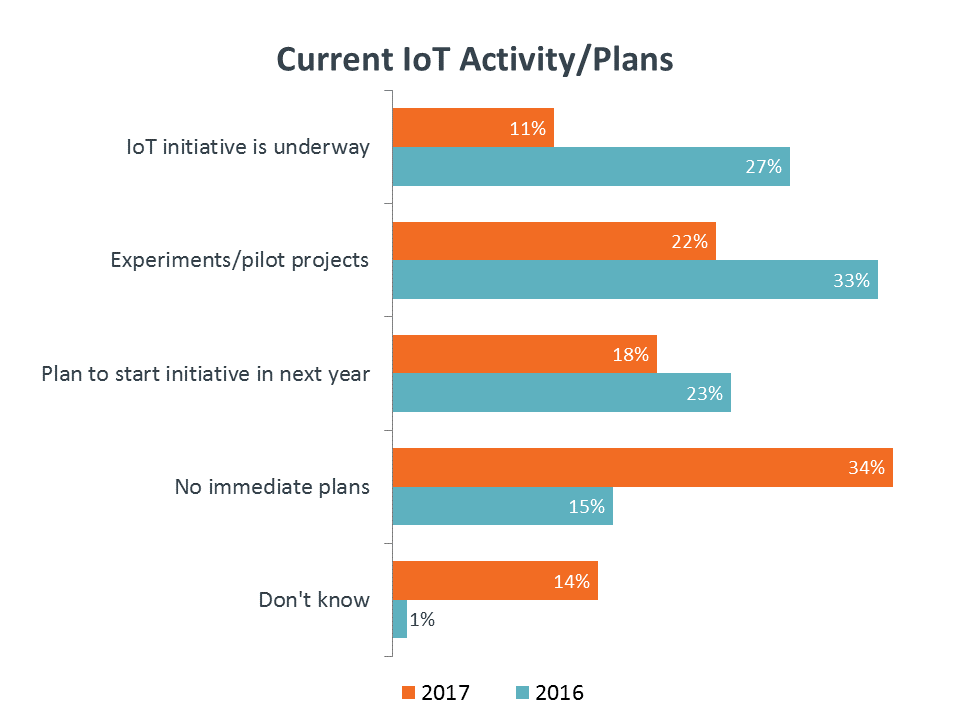
IoT activity declined year over year, reflecting a phenomenon also seen in the cloud market: initial enthusiasm inflates adoption numbers, but improved understanding brings a reality check. As companies build a better understanding of IoT systems, they recognize that some ongoing efforts do not fit the definition. The uncertainty over the meaning of IoT is also seen in the substantial jump of companies reporting they don’t know if there are IoT activities or plans.
One data point that is consistent year over year is the context for IoT initiatives. Sixty-one percent of companies report that IoT allows them to extend technology into broader organizational objectives. In contrast, 34% say that IoT initiatives are standalone activities. This positions IoT as one of the prime technologies driving digital transformation; rather than simply transitioning existing IT operations to new models, companies are digitizing their customary business operations and workflows.
Once again, this focus on the business side creates an excellent starting point for architectural planning. In this case, there is even greater opportunity for IT professionals and solution providers to introduce technology into the equation. Business units have high awareness of mobile applications and cloud software, but IoT is more nascent and the potential uses are less obvious.
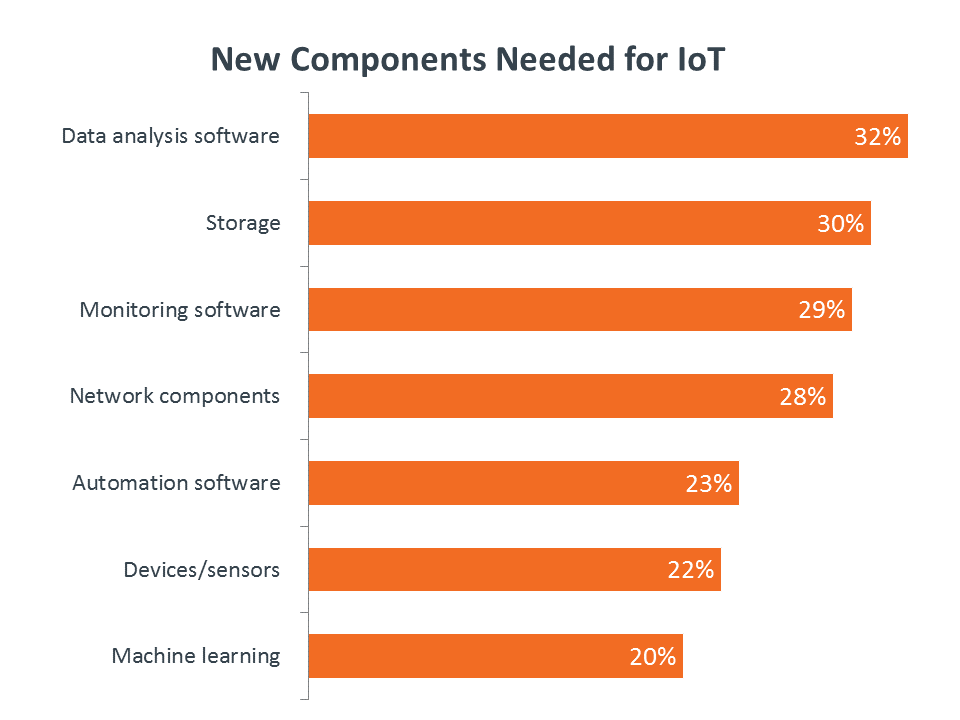
The wide range of technology needed for IoT necessitates a plan. One of the major challenges in today’s enterprise technology market is the expectations being created by the consumer space, and IoT is a prime example of this. Installing a connected thermostat is a relatively simple operation; implementing IoT for a business activity is clearly much more complex. After deciding on a technical solution that matches a business need, IT needs to fully explain the infrastructure needed to support that solution.
From that point, there are practical items to consider. In most cases, funding for IoT initiatives comes from new budget allocations. This further establishes IoT as a novel effort for businesses rather than an evolution of existing IT practices. As with most technology these days, there are many avenues for purchasing IoT components, especially since connected devices may be coming from non-traditional vendors. Large businesses are most likely to work with existing partnerships on IoT, but small firms have a tendency to work directly with vendors, likely procuring individual components without fully considering a holistic solution.
IoT, even more than cloud computing, shows that IT architecture planning is no longer exclusively the domain of large enterprises. In order to fully implement technology that transforms business operations, companies must give more serious thought to the ultimate goal for their IT systems and to the path they will take to get there.
This quantitative study consisted of an online survey fielded to U.S. workforce professionals during May 2017. A total of 500 businesses based in the United States participated in the survey, yielding an overall margin of sampling error proxy at 95% confidence of +/- 4.5 percentage points. Sampling error is larger for subgroups of the data.
As with any survey, sampling error is only one source of possible error. While non-sampling error cannot be accurately calculated, precautionary steps were taken in all phases of the survey design, collection and processing of the data to minimize its influence.
CompTIA is responsible for all content and analysis. Any questions regarding the study should be directed to CompTIA Research and Market Intelligence staff at [email protected].
CompTIA is a member of the market research industry’s Insights Association and adheres to its internationally respected Code of Standards.
Read more about IT Support and Help Desk.
Tags : IT Support and Help Desk